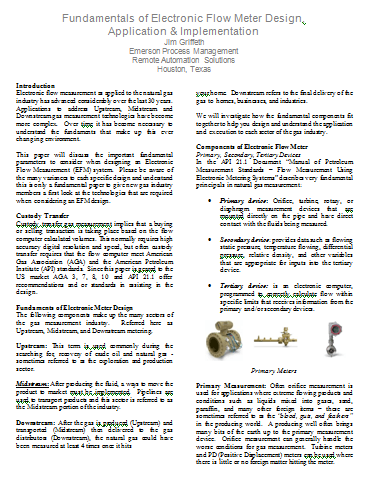 In the Emerson Exchange 365 community, I saw a new thread, Fundamentals of Electronic Flow Meter Design, Application & Implementation. It included a download link to a whitepaper with the same name by Emerson’s Jim Griffeth. Jim is a member of the Remote Automation Solutions team.
In the Emerson Exchange 365 community, I saw a new thread, Fundamentals of Electronic Flow Meter Design, Application & Implementation. It included a download link to a whitepaper with the same name by Emerson’s Jim Griffeth. Jim is a member of the Remote Automation Solutions team.
I wanted to highlight some of his thoughts from the whitepaper. Overall, it’s a very good overview of the flow measurement design process for custody transfer applications including all the components involved and how they fit together. If you’re new to one of the oil & gas upstream, midstream, or downstream business areas, this whitepaper is a great place to start.
He notes that the whitepaper was developed for the U.S. market and highlights some of the recommendations and/or standards provided by the American Gas Association (AGA) and American Petroleum Institute (API):
- AGA 3 – Orifice Metering of Natural Gas Part 2: Specification and Installation Requirements
- AGA 7 – Measurement of Natural Gas by Turbine Meter
- AGA 8 – Compressibility Factor of Natural Gas and Related Hydrocarbon Gases
- AGA 10 – Speed of Sound in Natural Gas and Other Related Hydrocarbon Gases
- API 21.1 – Flow Measurement Using Electronic Metering Systems – Section 1: Electronic Gas Measurement
Jim cites the API 21.1 standard for the basic components of an electronic flow measurement system, which includes primary devices, secondary devices, and tertiary devices. Primary devices have direct contact with the fluids being measured. These include orifice, turbine, rotary, or diaphragm measurement.
A secondary device:
…provides data such as flowing static pressure, temperature flowing, differential pressure, relative density, and other variables that are appropriate for inputs into the tertiary device.
The tertiary device:
…is an electronic computer, programmed to correctly calculate flow within specific limits that receives information from the primary and/or secondary devices.
The selection of a primary device should be a function of the fluid being measured. In oil & gas production there may be a mixture of gases, liquids, sands, waxy paraffin, and other particulates, which Jim describes in industry vernacular as, “blood, guts, and feathers.” Orifice measurement generally handles these dirty gas measurements best. Turbine and positive displacement (PD) meters work better where there are little or no foreign matter particulates. Ultrasonic meters are well suited for large gas volumes with varying flow rates. I described how ultrasonic flow meter worked in a post, Ultrasonic Flow Measurement and Diagnostic Advancements. Coriolis flow and density measurement is another technology used, that I highlighted in a post, Custody Transfer Flow Measurement.
For secondary measurement, Jim cites the AGA-3 recommended practice. For orifice measurement, differential pressure, static pressure, and flowing temperature are measured. Static and differential pressures and temperatures are often measured with multivariable transmitters. For turbine and PD meters, only static pressure and flow temperature measurement is required.
For some applications, the quality of the gas measurement is important and requires a gas chromatograph (GC) as part of the secondary devices. Jim notes:
A GC will sample the natural gas being measured and feed back an analysis of the gas to the Tertiary Device or flow computer. The flow computer uses this analysis to determine the compressibility of the gas along with flow volume. The flow computer will take this data and with the use of a calculation from AGA 8 determine the compressibility of the gas under flowing conditions.
Tertiary devices include the flow computer, solar/battery systems for remote installations, antenna systems, radio systems, and SCADA systems. On the software side, historical data editing systems keep the historical flow data of the specific measurements dictated by API 21.1. This historical data provides the opportunity to recalculate flow volumes should there have been an error such as incorrect orifice size entered into the historical record.
There is much more than I can give justice to in this post, so I’ll refer you to the whitepaper for more on these systems and software, as well as site requirements for upstream, midstream, and downstream applications.




